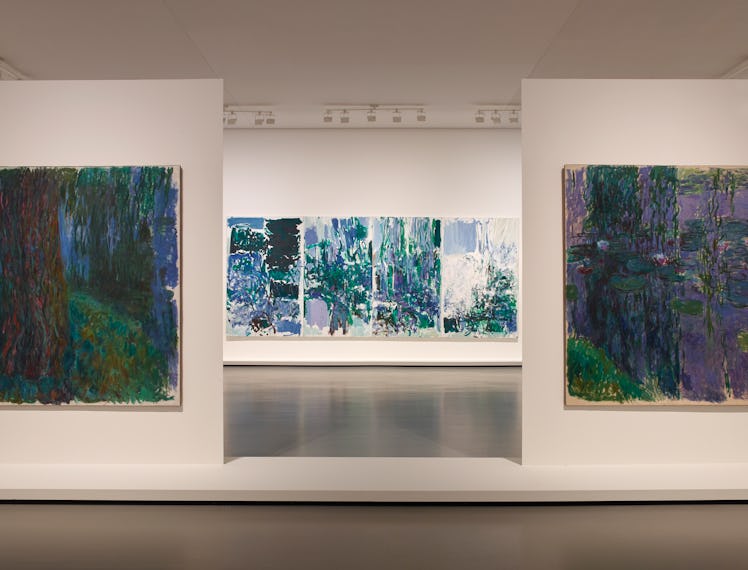Claude Monet and Joan Mitchell Meet in Paris
A new exhibition at the Fondation Louis Vuitton places the the impressionist and the abstract expressionist in conversation.

Joan Mitchell, the American painter widely regarded as a guiding light in the Abstract Expressionist movement, was born in 1925, in Chicago. Claude Monet, the revered French icon of Impressionism, died one year later, in 1926, in Giverny, France. At first glance, it’s hard to envision commonalities among the two painters. And yet, that’s exactly what Suzanne Pagé, Artistic Director of the Fondation Louis Vuitton in Paris, has done with the striking exhibition Monet - Mitchell, on view now until February 27, 2023.
Various scholars have made a connection between Monet’s later works and the origins of abstract expressionism, but never has there been a show placing Monet in direct dialogue with Mitchell. The exhibition, says Jean-Paul Claverie, Advisor to the President of the Fondation Louis Vuitton, was four years in the making. It is the latest example of the Fondation’s ongoing mission to connect different historical periods through commonalities between artists or artistic movements, and it required collaboration with collectors and institutions such as the Musée Marmottan Monet, which has the world’s largest collection of works by Monet.
One thing Monet and Mitchell shared was a subtly shifting but ever-present obsession with nature and landscapes—in some cases, the very same landscapes. Mitchell moved from America to Paris in 1959, but in 1968 settled permanently in Vétheuil, the village where Monet had lived from 1878 to 1881. It was there, with a large studio at her disposal, that Mitchell’s works soared not just in scale but in ambition. At the Fondation, Pagé gives those canvases plenty of room to breathe and stand on their own in a complementary retrospective devoted solely to Mitchell, situated in two large galleries on the lower level of the museum.
Paintings from Monet’s Nymphéas / Water Lilies series share space with Mitchell’s Row Row (1982) and Beauvais (1986) in Gallery 5.
For the juxtaposition between the two artists, Pagé zeroed in on Monet’s famous Water Lilies series, created during the last ten years of his life. It was only then, Pagé believes, that Monet felt truly free. “He once wrote that in this period of his life he was able to set aside all the formal rules of painting and focus instead on capturing the sensation behind the landscapes he depicted,” she says. In these works, lines are blurred, the edges of the canvases are often left untreated, and colors come alive in contact with each other. Mitchell, for her part, described decades later her interest in “what one color does to another and what they both do in terms of space and interaction.” And, as it turns out, examining the “sensation” of a place—the feelings she captured with paint as she mined memories and emotions anchored by specific natural settings—was also essential to Mitchell. (“I carry my landscapes with me,” she often declared.)
Claude Monet, Nymphéas, 1916 – 1919, Oil on Canvas
The exhibition also explores, among other topics, how friendships with leading poets of their respective eras influenced Monet and Mitchell’s compositions, and how they dealt with reflections and transparencies. Pagé shrewdly removed the frames from all the Monet canvases, further allowing them to meld into their shared space, and giving them a contemporary feel that only enhances the dialogue with Mitchell. A high point is the reconstitution of Monet’s famous Agapanthus triptych, which depicts a water lily pond in three panels. (The panels were sold separately in the 1950s to three American museums and had not been reunited since.) To end there are ten dense, energetic examples from Mitchell’s famous La Grande Vallée series, which consists of 21 paintings created between 1983 and 1984. This is the largest display of the series since its initial exhibition in 1984.
Claude Monet, L’Agapanthe, 1915-1926, Oil on Canvas
One could go on and on about the unexpected consonance between Monet and Mitchell. Ultimately, however, there is no need to overintellectualize: the similarities are immediately apparent to anyone with eyes. “The works speak for themselves,” Pagé says. “It’s the language of colors in a certain space. We just try and create a discourse between them.”
Joan Mitchell, La Grande Vallée XIV (For a Little While), 1983, Oil on Canvas.
This article was originally published on